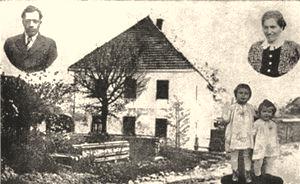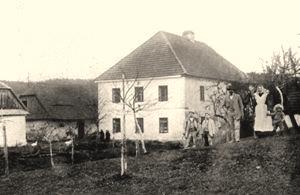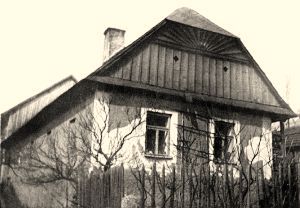 Ležáky nowadays a reverent area lays in Pradubice district, 30 kilometres southern from Pardubice at the area of Chrudim between the villages Miřetice and Včelákov. The name Ležák belonged to mill and also to the local brook and later also to the pond above the mill. Later on Ležáky also became a name of the colony. The oldest building, a remote place lying in the valley of Ležáky was the mill with sawmill that were firstly mentioned in 1714. The first two houses, one of Jiří Boháč with the house number 12 with a field and a meadow, and a house of Franc Hrabal with the house no. 11 with a meadow and a field, were built on the hillside above the brook in 1784. The written record about the first two houses of Ležáky is from the following year. In the process, especially in the nineteenth century the number of houses was increasing, both wooden and brick, for example numbers 23,26,27,28 and 29. There were never more than 8 houses and the ninth house was the mill with the number 26. In forties of nineteenth century its former owner Ignác Vybíral re-built it. Even though that there were no farms in the neighbourhood of the mill the building was prosperous even during both world wars.
Ležáky nowadays a reverent area lays in Pradubice district, 30 kilometres southern from Pardubice at the area of Chrudim between the villages Miřetice and Včelákov. The name Ležák belonged to mill and also to the local brook and later also to the pond above the mill. Later on Ležáky also became a name of the colony. The oldest building, a remote place lying in the valley of Ležáky was the mill with sawmill that were firstly mentioned in 1714. The first two houses, one of Jiří Boháč with the house number 12 with a field and a meadow, and a house of Franc Hrabal with the house no. 11 with a meadow and a field, were built on the hillside above the brook in 1784. The written record about the first two houses of Ležáky is from the following year. In the process, especially in the nineteenth century the number of houses was increasing, both wooden and brick, for example numbers 23,26,27,28 and 29. There were never more than 8 houses and the ninth house was the mill with the number 26. In forties of nineteenth century its former owner Ignác Vybíral re-built it. Even though that there were no farms in the neighbourhood of the mill the building was prosperous even during both world wars.
 A colony so small as Ležáky could never in the history manage itself economically and independently. The lives if its inhabitants always depended on cooperation with neighbouring villages for example Včelákovice or Miřetice that are closely related to the history of Ležáky.
A colony so small as Ležáky could never in the history manage itself economically and independently. The lives if its inhabitants always depended on cooperation with neighbouring villages for example Včelákovice or Miřetice that are closely related to the history of Ležáky.
The men of Ležáky used to go to make living to the close quarries. The first of those was opened in Dachov that was in the close neighbourhood of Ležáky- in 1942 it became famous as quarry Hluboká- and that was in the nineties of nineteenth century. In the neighbourhood there were in the process more quarries established. Hard plain granite used to be mined there and the stone-masons used to make cobblestones, kerbstones, tombstones and other products from it with their own hands. One of the localities was also well known quarry Čeník. All the places mentioned will become a part of the tragedy of Ležáky.
Women of Ležáky were famous for their embroidery that they used to take to Skuteč or Chrast for sale. Another option to make money- bor both men and women- were ancillary works for farmers from the neighbourhood during the harvest season.
Before the tragedy Ležáky were formed by nine buildings where 54 inhabitants lived. In the land register they belonged to the two neighbouring villages. The mill to the land register of village Dachov municipality Miřetice the rest eight houses to the village Hraboveč, municipality Louka. In accordance with this register separation there were schools in Miřetice and in Včelákov, the churches in Včelákov and in Vrbatův Kostelec. All inhabitants of Ležáky could use the railway station in Vrbatův Kostelec and the gendarmerie and the post office were seated there as well.
 The last miller of Ležáky was Jindřich Švanda born in 1904 who in August 1937 married Františka Šťulíková born in 1909 who was a daughter of the former miller Václav Šťulík. The Švanda couple had two daughters, Emilie (born in February 1939) and Bohumila (born in April 1940) and they were living happily in Ležáky. Thanks to Jindřich Švanda the mill was infirm hands.
The last miller of Ležáky was Jindřich Švanda born in 1904 who in August 1937 married Františka Šťulíková born in 1909 who was a daughter of the former miller Václav Šťulík. The Švanda couple had two daughters, Emilie (born in February 1939) and Bohumila (born in April 1940) and they were living happily in Ležáky. Thanks to Jindřich Švanda the mill was infirm hands.
In the first floor of the mill of Ležáky there lived, until June 21 1942, the brother of Františka Švandová Josef Šťulík who was born in the mill in 1913 and who in June 1939 married Marie, maiden name Pelikánová a native from Včelákov. The Šťulík couple had two daughters, Jarmila born in November 1939 and Marie born in July 1941. Josef Šťulík received working experience as a stone-mason and opened a quarry on the property belonging to the mill.